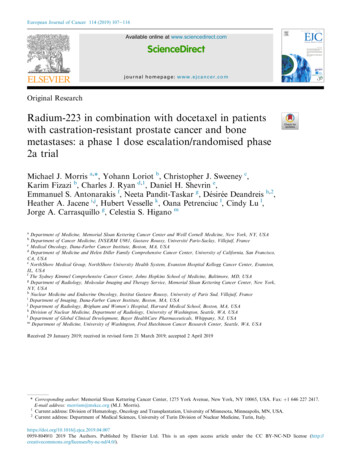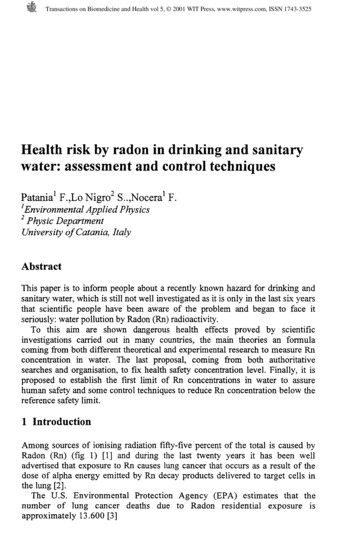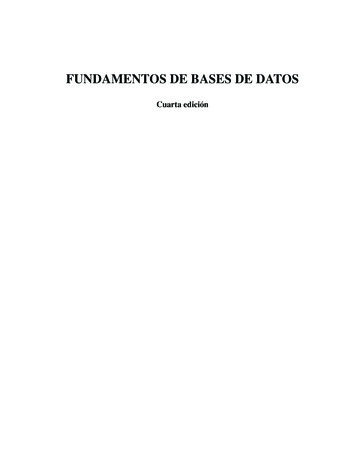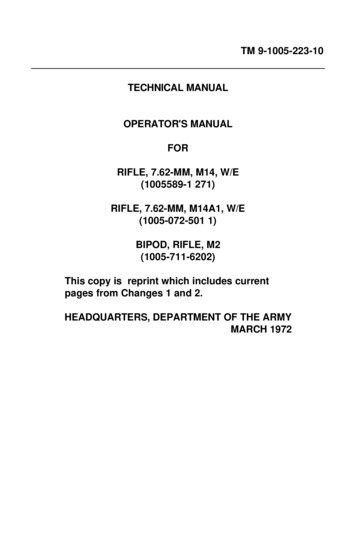
Transcription
European Journal of Cancer 114 (2019) 107e116Available online at www.sciencedirect.comScienceDirectjournal homepage: www.ejcancer.comOriginal ResearchRadium-223 in combination with docetaxel in patientswith castration-resistant prostate cancer and bonemetastases: a phase 1 dose escalation/randomised phase2a trialMichael J. Morris a,*, Yohann Loriot b, Christopher J. Sweeney c,Karim Fizazi b, Charles J. Ryan d,1, Daniel H. Shevrin e,Emmanuel S. Antonarakis f, Neeta Pandit-Taskar g, Désirée Deandreis h,2,Heather A. Jacene i,j, Hubert Vesselle k, Oana Petrenciuc l, Cindy Lu l,Jorge A. Carrasquillo g, Celestia S. Higano maDepartment of Medicine, Memorial Sloan Kettering Cancer Center and Weill Cornell Medicine, New York, NY, USADepartment of Cancer Medicine, INSERM U981, Gustave Roussy, Universite Paris-Saclay, Villejuif, FrancecMedical Oncology, Dana-Farber Cancer Institute, Boston, MA, USAdDepartment of Medicine and Helen Diller Family Comprehensive Cancer Center, University of California, San Francisco,CA, USAeNorthShore Medical Group, NorthShore University Health System, Evanston Hospital Kellogg Cancer Center, Evanston,IL, USAfThe Sydney Kimmel Comprehensive Cancer Center, Johns Hopkins School of Medicine, Baltimore, MD, USAgDepartment of Radiology, Molecular Imaging and Therapy Service, Memorial Sloan Kettering Cancer Center, New York,NY, USAhNuclear Medicine and Endocrine Oncology, Institut Gustave Roussy, University of Paris Sud, Villejuif, FranceiDepartment of Imaging, Dana-Farber Cancer Institute, Boston, MA, USAjDepartment of Radiology, Brigham and Women’s Hospital, Harvard Medical School, Boston, MA, USAkDivision of Nuclear Medicine, Department of Radiology, University of Washington, Seattle, WA, USAlDepartment of Global Clinical Development, Bayer HealthCare Pharmaceuticals, Whippany, NJ, USAmDepartment of Medicine, University of Washington, Fred Hutchinson Cancer Research Center, Seattle, WA, USAbReceived 29 January 2019; received in revised form 21 March 2019; accepted 2 April 2019* Corresponding author: Memorial Sloan Kettering Cancer Center, 1275 York Avenue, New York, NY 10065, USA. Fax: þ1 646 227 2417.E-mail address: morrism@mskcc.org (M.J. Morris).1Current address: Division of Hematology, Oncology and Transplantation, University of Minnesota, Minneapolis, MN, USA.2Current address: Department of Medical Sciences, University of Turin Division of Nuclear Medicine, Turin, 59-8049/ª 2019 The Authors. Published by Elsevier Ltd. This is an open access article under the CC BY-NC-ND license ).
108KEYWORDSCastration-resistantprostate cancer;Radium 223dichloride;Docetaxel;CombinationtreatmentM.J. Morris et al. / European Journal of Cancer 114 (2019) 107e116Abstract Purpose: Radium 223 dichloride (radium-223) is an alpha particleeemitting bonedirected therapy that prolongs overall survival in men with bone-predominant metastaticcastration-resistant prostate cancer (mCRPC). Docetaxel is an antimicrotubule cytotoxicagent that improves survival in mCRPC. We investigated whether combining these potentiallycross-sensitising agents to dually target tumour and bone would be safe and effective.Patients and methods: Phase 1 was a dose escalation study to define a recommended phase 2dose (RP2D) of docetaxel and radium-223. In phase 2a, patients were randomised 2:1 to therecommended combination regimen or docetaxel at a dose of 75 mg/m2 every 3 weeks (q3w).Patients with bone-predominant mCRPC were eligible. End-points were safety, efficacy andtreatment-related changes in serum and imaging biomarkers.Results: Twenty patients were enrolled in phase 1; 53 patients were randomised in phase 2a: 36to combination treatment and 17 to docetaxel alone. The RP2D for the combination wasradium-223 55 kBq/kg every six weeks 5 doses, plus docetaxel 60 mg/m2 q3w 10 doses.Febrile neutropenia was dose limiting. A higher rate of febrile neutropenia was seen in the docetaxel monotherapy arm (15% vs 0%); the safety profile of the treatment groups was otherwisesimilar. The combination arm had more durable suppression of prostate-specific antigen (median time to progression, 6.6 vs 4.8 months, respectively), alkaline phosphatase (9 vs 7months) and osteoblastic bone deposition markers.Conclusions: Radium-223 in combination with docetaxel at the RP2D was well tolerated.Exploratory efficacy data suggested enhanced antitumour activity for the combination relativeto docetaxel alone. Comparative studies with end-points of clinical benefit are warranted.ClinicalTrials.gov number: NCT01106352.ª 2019 The Authors. Published by Elsevier Ltd. This is an open access article under the CCBY-NC-ND license ).1. IntroductionProstate cancer is bone-tropic, rendering it particularlysusceptible to treatments that target bone formation andosteoblastic activity. The cancer-induced abnormal bonemetabolism that places patients at risk of death andmorbidity can also be leveraged to deliver lifeprolonging therapy.Radium 223 dichloride (radium-223), a calciummimetic alpha particleeemitting radiopharmaceutical,targets hydroxyapatite. It selectively accumulates inareas of increased bone turnover that surround metastatic lesions, where it emits four high-energy, shortrange ( 100 mm) alpha particles with resulting minimalradiation effects on the adjacent bone marrow [1,2]. Inpreclinical models, it reduces abnormal bone production, tumour burden and dysregulated bone deposition[3,4]. Clinically, radium-223dgiven at a dose of 55 kBq/kg every 4 weeks for 6 dosesdprolongs life and the timeto first symptomatic skeletal event in patients with bonepredominant metastatic castration-resistant prostatecancer (mCRPC) and no known visceral metastases [5].Docetaxel is a chemotherapeutic agent that interfereswith microtubule dynamics and has a radiosensitisingeffect [6]. Docetaxel given at a dose of 75 mg/m2 every 3weeks (q3w) in combination with prednisone prolongslife in patients with mCRPC [7].We hypothesised that combining bone-targeted alpharadiation therapy with chemotherapy in patients withmCRPC might be an effective treatment approach,predicated on the concepts of multicompartmenttargeting and possible cross-sensitisation in bone lesions[8]. We conducted a phase 1/2a study to investigate thiscombination.2. Patients and methods2.1. PatientsEligible patients had progressive mCRPC with 2 bonemetastases, testosterone 50 ng/dL, Karnofsky Performance Status of 70%, life expectancy of 6 months andadequate organ functionality (white blood cell count 3 109/L, with an absolute neutrophil count 1.5 109/L, a platelet count 100 109/L and haemoglobin 10.0 g/dL; total bilirubin level upper limitof normal (ULN) and aspartate aminotransferase andalanine aminotransferase concentrations 1.5 ULN;creatinine 1.5 ULN and albumin 30 g/L). The patients needed to have had two consecutive prostatespecific antigen (PSA) increases at least one week apart,with a minimum value of 2 ng/mL at screening, or two ormore new bone lesions when analysed by bone scintigraphy. Those patients on a first-generation androgen inhibitor needed to progress through a 4-week withdrawal.The exclusion criteria included the following: visceralmetastases, defined as 2 lung metastases and/or livermetastases that were 2 cm in size, symptomatic nodaldisease and malignant lymphadenopathy 3 cm in shortaxis diameter. Patients should not have received 10
M.J. Morris et al. / European Journal of Cancer 114 (2019) 107e116previous docetaxel doses or previous treatment with abone-seeking radiopharmaceutical.2.2. Study designThis two-part phase 1/phase 2a study, conducted at eightcentres, seven in the United States and one in France,aimed to establish a recommended phase 2 dose (RP2D)of radium-223 in combination with docetaxel and toinvestigate safety and exploratory efficacy end-points atthe RP2D.In phase 1, between 9 and 18 patients were to beenrolled and treated according to a 3 þ 3 design. Thedose escalation scheme is shown in Fig. 1A. Doselimiting toxicity (DLT) was assessed during the 6-weekperiod after the first radium-223 injection. DLT wasdefined as absolute neutrophil count 0.5 109/L for 7 days without fever despite granulocyte-colony stimulating factor support, grade 3 febrile neutropenia(after a protocol amendment), platelet count 25 109/L for 7 days, grade 3 diarrhoea despite optimalmedical management, grade 4 vomiting orconstipation.Radium-223 was started at a dose of 27.5 kBq/kg (according to the National Institute of Standards andTechnology [NIST] 2016 update [9]), every six weeks(q6w), and could be escalated to 55 kBq/kg (according toNIST 2016 update [9]). The starting dose of docetaxelwas 75 mg/m2 q3w, with a planned reduction to 60 mg/m2in the event of DLT. We prioritised achieving full-doseradium-223 over full-dose chemotherapy in the doseescalation scheme, given that there are survival datausing docetaxel as part of combination therapy at itsstep-down dose but no survival data using a lower doseof radium-223 [10]. Radium-223 was administered everyother chemotherapy dose rather than monthly to optimise the likelihood of patient acceptance and complianceby having only one day of treatment per cycle, at a dosinginterval known to have favourable clinical effects [11].The number of doses was capped at five in an abundanceof caution to protect long-term marrow integrity in theevent of enhanced toxicity that would not be detected byblood count assessments during treatment. In all cohorts,docetaxel was to be administered every 3 weeks and wasto be continued in the absence of progressive disease orunacceptable toxicity. Docetaxel and radium-223 wereadministered on the same day, with docetaxel administered first, followed by radium-223 as soon as practicallyfeasible. Prednisone 5 mg was given orally twice daily,continuously. Dexamethasone premedication was givenbefore docetaxel dosing as per each institution’s practice.Growth factor support was allowed only as secondaryprophylaxis.In phase 2a, using a schedule generated by an independent statistician, patients were randomly assignedcentrally 2:1, using a block randomisation scheme(block size of three), via an interactive voice response109system, to combination therapy or docetaxel alone,respectively. A preplanned early stopping rule appliedin the event of significant toxicity in the combinationarm. The treatment period was a maximum of 30weeks (10 doses of docetaxel), followed by 22 weeks offollow-up.The study was conducted in accordance with theDeclaration of Helsinki and the International Conference on Harmonisation E6, Good Clinical Practice. Theprotocol and all amendments were approved by the independent ethics committee/institutional review boardsat each site, and written informed consent was obtainedfrom the patients before any assessments wereperformed.2.3. AssessmentsAdverse events (AEs) were coded according to theMedical Dictionary for Regulatory Activities version13.0. Severity was graded according to the NationalCancer Institute Common Terminology Criteria forAdverse Events version 4.0. The safety assessmentperiod for AEs was from the start of study treatment to6 weeks after the end of study treatment (8 weeks forserious AEs [SAEs]). Data on marrow sequelae and anysecond malignancies were collected up to 12 monthsafter the start of study treatment. Exploratory efficacyassessments included on-treatment changes in bonealkaline phosphatase (bALP), total ALP (tALP), urinary C-telopeptide of type 1 (uCTX-1), N-terminalpropeptide of procollagen type 1 (P1NP), pyridinolinecross-linked carboxyterminal telopeptide (ICTP),PSA and circulating tumour cells (CTCs).2.4. Statistical considerationsThe primary objectives were to establish a recommendeddose of radium-223 combined with docetaxel and toinvestigate safety and explore efficacy at this dose level.The safety population included all patients who receivedtreatment. To examine the antitumour effect of treatment in this exploratory study, the efficacy populationcomprised patients who received 40% (2 infusions) ofthe specified number of radium-223 doses (combinationarm) or docetaxel doses (docetaxel arm) and had nomajor protocol violations (per protocol population). Noformal statistical testing was planned.Exploratory efficacy end-points included time to PSAprogression, time to bALP progression, time to tALPprogression, time to first radiographic or clinical progression based on Response Evaluation Criteria in SolidTumours (RECIST) [12] version 1.1 and Prostate CancerWorking Group 2 (PCWG2) [13] definitions and overallsurvival. Time-to-event end-points were measured fromthe first dose of study treatment. For this report,progression-free survival (PFS) events are defined asradiographic or clinical progression or death. Medians
110M.J. Morris et al. / European Journal of Cancer 114 (2019) 107e116ABCFig. 1. Study profile. (A) Dose escalation scheme.*A return to the very first dose cohort could be considered in the event of 0/3 or 2/6DLTs at 55 kBq/kg radium-223 þ 60 mg/m2 docetaxel q3w. If then 2/3 or 2/6 DLTs occurred at docetaxel 75 mg/m2, the chosen regimenfor the phase 2a cohort was to be radium-223 50 kBq/kg 5 þ docetaxel 60 mg/m2 q3w 10. (B) Phase 1 dose escalation cohorts. *Onepatient was replaced, unable to receive both combined doses of radium-223 and docetaxel because of docetaxel hypersensitivity.yWithdrew before receiving both doses of radium-223 to receive another treatment deemed necessary by the study sponsor. zWithdrewafter receiving both doses of radium-223, too ill to attend the 12-month follow-up visit. (C) Phase 2a safety and efficacy cohort.*25patients in the combination arm received all planned radium-223 doses, 20 patients in the combination arm and 5 patients in the docetaxelarm received all planned docetaxel doses; the dose for 4 patients in the docetaxel arm was stepped down to 60 mg/m2. The study wascompleted through 12 months of follow-up from the start of treatment with 23 (70%) patients in the combination arm and 9 (69%) in the
M.J. Morris et al. / European Journal of Cancer 114 (2019) 107e116for time-to-event variables were estimated using theKaplaneMeier method. Changes in biomarkers overtime were computed as the area under the bone markercurve. Based on the Lehmann alternative power functionfor a two-sided 0.05-level test, the planned 42 patientswere to be randomised. Assuming for a given marker thatthe odds were 3:1 that a patient in the combination grouphad a greater area under the bone turnover curve relativeto a patient in the docetaxel group, the power of the testwas 0.78. P values for exploratory efficacy end-pointshave not been corrected for multiplicity of testing and areprovided for information only.3. Results3.1. Phase 1 dose escalationSeventeen patients were treated in the phase 1 dose escalation cohort, including three with visceral disease; patientdisposition and baseline characteristics are summarised inFig. 1B and Supplementary Table 1. No DLTs occurredamong the first three patients treated at full-dosechemotherapy and half-dose radium-223 (27.5 kBq/kg),but two developed febrile neutropenia, which was notthen specified as a DLT. The cohort was expanded to sixpatients; no DLTs or additional febrile neutropeniaevents were seen. Owing to febrile neutropenia in two ofsix patients, the docetaxel dose was reduced to 60 mg/m2in the second cohort, which also used radium-223 at a doseof 27.5 kBq/kg. No DLTs were seen in the first three patients enrolled in this cohort. Because it appeared that thedocetaxel dose at 75 mg/m2 was accounting for the neutropenic fevers, the radium-223 dose was escalated to 55kBq/kg in the third cohort, holding the docetaxel dose at60 mg/m2. No DLTs were seen in the first three patientsenrolled at this dose level. However, one patient developed grade 3 neutropenia and another developed grade 4neutropenia, both without fever or infection. Afterreviewing the safety data, it was decided to add three morepatients to this cohort. No DLTs occurred in these patients. The third cohort dose (55 kBq/kg radium q6w 5and 60 mg/m2 docetaxel q3w 10) was consequentlyselected as the RP2D to be administered over 30 weeks.Haematological treatment-emergent AEs (TEAEs)occurring in phase 1 are shown in Supplementary Table 2.3.2. Phase 2a cohort3.2.1. Patients and treatmentBetween December 19, 2012, and April 7, 2014, 53 patients were randomly assigned to receive combination111therapy with docetaxel 60 mg/m2 and radium-223 55kBq/kg q6w 5 (n Z 36) or docetaxel alone, at astandard dose of 75 mg/m2 q3w 10 (n Z 17, Fig. 1C,Supplementary Fig. 1); seven patients were found not tobe eligible and were not treated. Baseline characteristicswere similar between treatment groups (Table 1). Seven(15%) of 46 eligible patients had visceral metastases atbaseline, five in the combination arm and two in thedocetaxel arm.3.2.2. Treatment exposureThe patients in the combination arm received a cumulative median of 1187 mg of docetaxel (range,250e1520), versus 1270 mg (range, 643e1600) in thedocetaxel monotherapy arm. The median number ofdocetaxel doses was 10 (range, 2e11) in the combinationarm and 9 (range, 4e10) in the monotherapy arm. Themedian number of radium-223 doses in the combinationarm was 5 (range, 1e5).In the combination therapy arm, radium-223 anddocetaxel administration was delayed in two patientsbecause of TEAEs (cellulitis and osteoporosis), withdocetaxel administration delayed in a further five patients (because of back pain, pain in extremity; oralabscess; pneumonia; toothache; diarrhoea, dehydration,pleural effusion, acute respiratory failure and pneumonia). There were three dose delays because of TEAEsin the docetaxel arm (hypotension; influenza-like illness,cough and melaena; cellulitis). In the combination arm,radium-223 and docetaxel were discontinued in 4 of 33(12%) patients because of TEAEs (unilateral blindness;cerebrovascular accident; pneumonitis; asthenia andback pain), and docetaxel was discontinued in a furthertwo (6%) patients (peripheral neuropathy; asthenia). Inthe docetaxel arm, 3 of 13 (23%) patients discontinuedtreatment because of TEAEs (febrile neutropenia;interstitial lung disease; peripheral neuropathy).3.2.3. SafetyTEAE and TESAE incidence in the phase 2a safety population is summarised in Table 2 and SupplementaryTable 3. Notably, there was less toxicity of any gradeseen with combination therapy than docetaxel alone forneutropenia, febrile neutropenia, fatigue, dyspnoea,arthralgia and nausea. However, combination therapywas associated with more diarrhoea and back pain. Theincidence of grade 3 or 4 TEAEs was low in both arms(Table 2), with the exception of neutropenia. Febrileneutropenia occurred in two patients (one grade 3 and onegrade 4) in the docetaxel arm and none in the combinationarm; growth factors were used to prevent or resolve neutropenia in four patients in the combination arm and twodocetaxel arm. yReceived at least 40% of drug dose, no protocol violation. UIncluding the one patient who was excluded from the perprotocol population. zAll deaths occurred during follow-up and were due to disease progression. x3 patients entered hospice, and 1 haddisease progression. PD, progressive disease; DLT, dose-limiting toxicity; ITT, intention to treat; q3w, every 3 weeks; q6w, every 6 weeks.
112M.J. Morris et al. / European Journal of Cancer 114 (2019) 107e116Table 1Baseline characteristics (phase 2a cohort).CharacteristicRadium-223 þ docetaxelN Z 33DocetaxelN Z 13Age, median (range), yearsWeight, median (range), kgKarnofsky Performance Status, median %, (range)Albumin, median, g/LHaemoglobin, median, g/LPSA ULN, N (%)Median (range), mg/LTotal ALP ULN, N (%)Median (range), U/LBone ALP ULN, N (%)Median (range), mg/LLDH ULN, N (%)Median (range), U/LPatients with visceral metastatic lesions, N (%)AnyLungLiverOtherExtent of disease (number of bone lesions), N (%)2e45e910e20 20Time since initial diagnosis, median (range), monthsTime since bone metastases, median (range), monthsPrior anticancer therapies, N (%)Hormonal therapiesAbiraterone þ timulantsSipuleucel-TBone-modifying agents, N (%)BisphosphonatesDenosumabOther, N (%)Radiation68 (49e82)87 (61e120)90 (70e100)43.0122.067 (55e82)78 (69e132)90 (70e100)43.0121.032 (97)99 (3e1000)13 (100)43 (4e1042)20 (61)167 (62e1016)10 (77)186 (74e472)23 (70)36 (10e331)11 (85)47 (16e164)6 (18)191 (123e418)2 (15)190 (124e328)5 (15)1 (3)04a (12)2 (15)1 (8)01b (8)4 (12)7 (21)9 (27)13 (39)73 (7e292)23 (1e58)03 (23)4 (31)6 (46)45 (12e274)10 (0e92)25 (76)3 (9)8 (62)5 (38)2 (6)06 (18)4 (31)13 (39)12 (36)5 (38)3 (23)24 (73)9 (69)ALP, alkaline phosphatase; LDH, lactate dehydrogenase; PSA, prostate-specific antigen; ULN, upper limit of normal.aAdrenal (2 patients), pleura, pancreas.bAdrenal.patients in the docetaxel arm. There were no TEAEs ofthrombocytopenia reported in either arm during thetreatment period, and median platelet laboratory valueswere similar for both treatment groups between baselineand day 8 (Supplementary Fig. 2). There were no grade 5TEAEs. No fractures were observed.3.2.4. EfficacyPSA declines of 50% occurred in 61% of patients in thecombination arm and 54% of patients in the docetaxelarm (Supplementary Fig. 3A). Plots of PSA level relativeto baseline from week 4 to end of treatment show similarprofiles for both arms, but PSA suppression was morepronounced with the combination arm (SupplementaryFig. 4A, Supplementary Table 4). A longer time toPSA progression was also observed with the combination arm (Fig. 2A; median, 6.6 vs 4.8 months).The median PFS was 12.0 months in the combinationarm and 9.3 months in the docetaxel arm (Fig. 2D).Twelve-month overall survival rates were similar (89%and 90%, respectively), although the high level ofcensoring precluded meaningful analysis. Disease progression based on RECIST and PCWG2 criteria isshown in Supplementary Table 5.Changes in bone marker levels indicated a greatersuppression of osteoblastic activity in the combination
M.J. Morris et al. / European Journal of Cancer 114 (2019) 107e116113Table 2TEAEs in the phase 2a treatment period (any grade and grade 3 or 4): safety aLeucopeniaLymphopeniaFebrile eaBack painAlopeciaPeripheral oedemaConstipationDecreased appetitePeripheral nal reflux diseaseAny gradeGrade 3 or 4Radium223 þdocetaxelN Z 33DocetaxelN Z 13Radium223 þdocetaxelN Z 33DocetaxelN Z 1333 (100)13 (100)16 (48)8 (62)10 (30)3 (9)2 (6)1 (3)051202(15)10 (30)1 (3)2 (6)1 (3)05 (38)02 (15)02 (15)17 (52)16 (48)15 (45)13 (39)12 (36)12 (36)11 (33)11 (33)10 (30)7 (21)7 (21)2 (6)1 1)(62)(46)(38)(31)001 (3)2 (6)000000000000001 (8)0000000(38)(8)(15)TEAEs, treatment-emergent adverse events.Data are number of patients (%).aSelected because of their relevance to radium-223 and chemotherapy.bAny grade occurring in 25% of patients in either treatment group.arm (Supplementary Fig. 3B, 3C, 4B, C, SupplementaryTable 4). For both tALP and bALP, a longer mediantime to progression was observed for combination armpatients than docetaxel arm patients (9.0 vs 6.9 and 9.3vs 7.4 months, respectively; Fig. 2B and C).P1NP showed a decline pattern favouring the combination similar to that for bALP (SupplementaryFig. 3D, 4D). The weighted median area under thetimeeactivity curve for P1NP was substantially smallerfor the combination arm (25.0 v 46.2 mg*day/L),reflecting greater suppression of this marker(Supplementary Table 6).Markers of osteoclastic activity, uCTX-1 and ICTP,showed similar patterns of decrease during treatment forcombination arm and docetaxel arm patients(Supplementary Fig. 3E, 3F, Fig. 4E, F, SupplementaryTable 6).An antitumour treatment effect in both arms wassuggested by the decrease in CTCs (SupplementaryTable 7).4. DiscussionTo our knowledge, this trial is the first to explore theconcept of dual targeting of osteoblastic bone andcancer cells using two concurrent agents, radium-223and docetaxel, both of which prolong survival in patients with mCRPC. The concept of targeting bone andtumour is not novel. Prior studies have examineddocetaxel in combination with bone-targeting agentsthat are not known to prolong survival, ediphosphonate [14,15]. These studies only used one ortwo doses of the bone-seeking radiopharmaceutical,rather than as a repetitively dosed regimen integratedwith chemotherapy. Neither of these studies yielded datasufficiently promising to warrant advancement to phase3. This study, however, used only life-prolonging agentsin a regimen in which patients were exposed to bothagents throughout the treatment. Although the combination arm used the step-down dose of docetaxelcommonly applied in clinical practice, the cumulativeexposure to docetaxel in the two arms of the phase 2acohort was similar, and the combination was associatedwith less neutropenia, fatigue, and certain gastrointestinal toxicities. Another factor that may have contributed to the safety profile of the combination is that weadministered five doses of radium q6w, rather than sixdoses every four weeks. Combination therapy appearedto increase the proportion of patients with substantial
114M.J. Morris et al. / European Journal of Cancer 114 (2019) 107e116Fig. 2. KaplaneMeier plots for (A) time to PSA progression; (B) time to tALP progression; (C) time to bALP progression and (D)radiographic or clinical progression-free survival. *Per protocol population; intent-to-treat patients who received 40% of specifiednumber of radium-223 injections or docetaxel, per dose escalation study results, and have no major protocol violations. yAs per ProstateCancer Working Group 2 (PCWG2). PSA progression for patients with an initial PSA decline from baseline is defined as a PSA increase 25% and 2 ng/mL above nadir, confirmed 3 weeks later; for those with no PSA decline from baseline, progression is defined as a PSAincrease 25% and 2 ng/mL above baseline after 12 weeks. ztALP/bALP progression for patients with an initial decline in tALP/bALPfrom baseline was defined as a tALP/bALP increase 25% above the nadir, confirmed 3 weeks later; for patients with no tALP/bALPdecline from baseline, progression was defined as a tALP/bALP increase 25% above the baseline after 12 weeks. UTime to radiographicor clinical progression is a composite end-point encompassing time to first radiographic or clinical progression or death. bALP, bonealkaline phosphatase; CI, confidence interval; PSA, prostate-specific antigen; tALP, total alkaline phosphatase.declines in levels of PSA and bone formation biomarkers relative to docetaxel alone and appeared todelay time to progression of these markers.The safety of this combination is increasingly clinically relevant. Patients generally receive abiraterone orenzalutamide as first-line therapy for mCRPC, withchemotherapy reserved for second-line or beyond. Afterabiraterone or after enzalutamide therapy, patientsfrequently manifest both bony disease and soft tissuedisease [16,17] and remain sensitive to chemotherapydespite the presence of molecular changes that mayrender tumours resistant to further androgen receptor(AR)edirected therapy [18]. We therefore have anincreasing clinical need for a regimen that is non-ARdirected and delivers potent therapy both systemically tothe cancer cells and also to the osteoblasts surroundingmetastatic bone lesions. Radium-223 and docetaxelappear to fulfil these criteria well. This trial suggests thatsuch an approach is safe, with patients followed up for 1year without the emergence of long-term safety concerns. It is unknown whether the combination prolongsoverall survival compared with radium-223 or docetaxelalone, thus warranting further investigation.5. ConclusionsThis study showed that radium-223 (55 kBq/kg q6w)plus docetaxel (60 mg/m2 q3w) was well tolerated andpresented no greater safety concerns than docetaxelalone (75 mg/m2 q3w). Exploratory efficacy data suggested enhanced antitumour activity in the combinationarm. Based on these results, the radium-223/docetaxelcombination will be further explored in a phase 3 trialin patients with bone metastatic CRPC (NCT03574571).Role of the funding sourceThe study was designed by the funder in conjunctionwith the coordinating investigator (M.J.M.). The fundercollected, analysed and interpreted the study data incollaboration with the authors and commissioned
M.J. Morris et al. / European Journal of Cancer 114 (2019) 107e116medical writing support for the drafting of the report.M.J.M. had the final responsibility for the decision tosubmit for publication.Conflict of interest statementM.J.M. discloses consultancy/advisory roles withAstellas Pharma, Bayer, Endocyte and Advanced Accelerator Applications and has received travel/accommodation expenses from Bayer and Endocyte, and hisinstitution has received research funding from Bayer,Endocyte, Progenics and Sanofi; Y.L. discloses consultancy/advisory roles with Astellas Pharma, AstraZeneca,Janssen, Merck Sharp & Dohme, Pfizer, Roche, SeattleGenetics and Sanofi, and his institution has receivedresearch funding from Sanofi; C.J.S. declares stockownership in relation to Leuchemix, consultancy/advisoryroles with Astellas Pharma, AstraZeneca, Bayer, Genentech/Roche, Janssen Biotech, Pfizer and Sanofi and intellectual property interests in relation to Leuchemix andExelixis, and his institution has received research fundingfrom Astellas Pharma, Bayer, Janssen Biotech, Sanofi andSotio; K.F. has received honoraria from Bayer and Sanofi,discloses consultancy
d Department of Medicine and Helen Diller Family Comprehensive Cancer Center, University of California, San Francisco, CA, USA e NorthShore Medical Group, NorthShore University Health System, Evanston Hospital Kellogg Cancer Center, Evanston, IL, USA f The Sydney Kimmel Comprehensive Cancer Center, Johns Hopkins School of Medicine, Baltimore .










